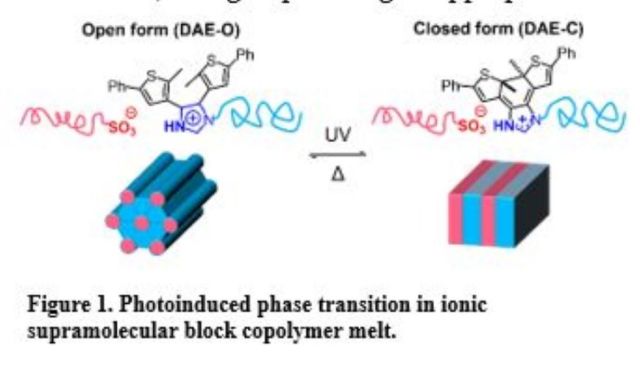"Ion-mediated polymer assemblies with tunable structures"
K. M. Karnaukh a,b, S. Xie a,c, K-C. Yang d, D. Sun b, G. H. Fredrickson a,c,d , R. A. Segalman a,c,d J. Read de Alaniz b
aMaterials Research Laboratory, bDepartment of Chemistry and Biochemistry, cMitsubishi Chemical Center for Advanced Materials, dDepartment of Chemical Engineering, University of California, Santa Barbara, California 93106, United States Phase separation of immiscible polymers is a critical obstacle facing plastics recycling. One strategy to prevent macroscopic phase separation is by chain-end functionalization of dissimilar polymers with reacting cation/anion groups.1 This non-covalent interaction leads to the formation of supramolecular block copolymers (SBCPs) via “reactive blending,” which can self-assemble and form various microstructures. To further study their self-assembly and dynamics, we have synthesized a library of new ionic-bonded polystyrene/polydimethylsiloxane (PS/PDMS) SBCP blends by attaching compact ions with different degrees of charge delocalization and pKa values onto the chain ends. Using X-ray scattering and microscopy techniques, we have demonstrated the formation of lamellar microstructures produced by stronger cation-anion interactions and more swollen microphases with no long-range order by weaker interactions.2

To further demonstrate the tunability of this approach, we also show that self-assembly can be modified on-demand with UV light. By incorporating a photochromic diarylethene (DAE) end-group bearing an appropriate base unit, we enable control of the localization of positive charge upon irradiation and, therefore, the strength of ionic interactions in functionalized polydimethylsiloxane with a sulfonic acid end-functionalized polystyrene blend. Specifically, the proton transfer between the acid and base units in the melt state yields contact ion pairs that self-assemble into a cylindrical microstructure. By shining UV light, we can induce photoisomerization of the diarylethene unit from the ring-open form (DAE-O) to the ring-closed state (DAE-C). Formation of the DAE-C structure, which has a more localized positive charge and stronger ionic bonds, induces a phase transition to a lamellar microstructure. Compatibilization of immiscible polymer blends by introducing ionic bonds and understanding the parameters that influence the tunability of microphases in such SBCPs can significantly expand the types of polymers that can be recycled.
This work was supported by the MRSEC Program of the National Science Foundation under award no. DMR 1720256 (IRG-2).
References:
1. Fredrickson, G. H.; et al. Ionic Compatibilization of Polymers. ACS Polym. Au 2022, 2, 299.
2. Xie, S.; Karnaukh, K. M.; et al. Compatibilization of Polymer Blends by Ionic Bonding. Macromolecules 2023, 56, 10, 3617.